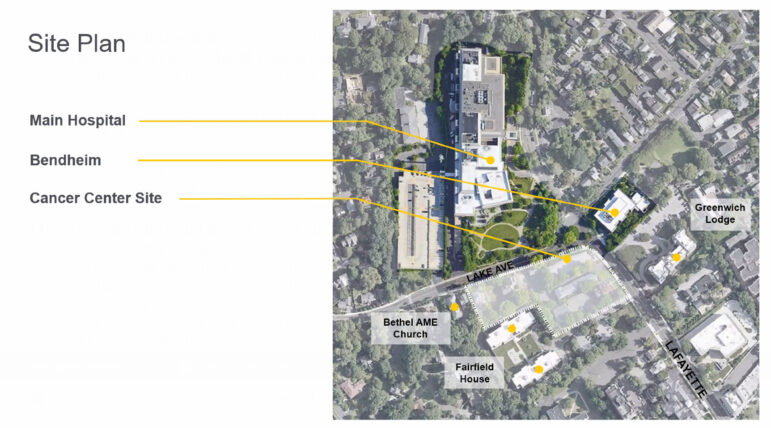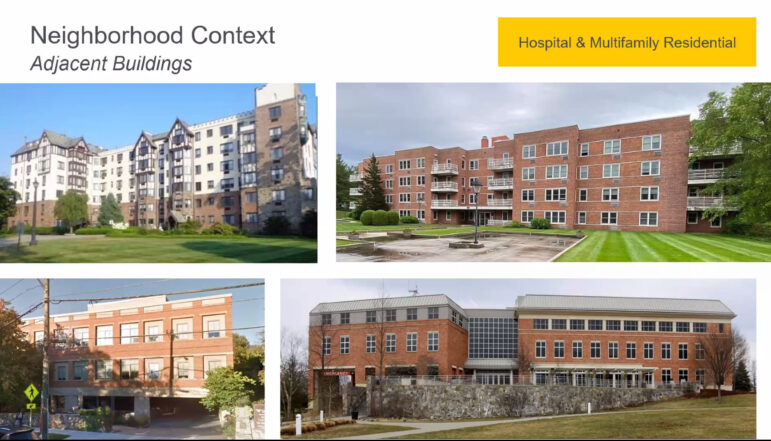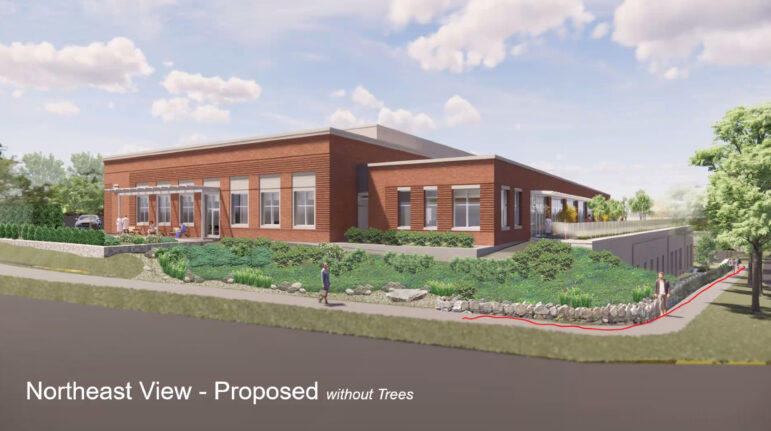Greenwich Hospitals application for a proposed Smilow Cancer Center went before P&Z again on July 7. It would would be on the corner of Lake Ave and Lafayette Place, replacing a row of seven houses and medical offices along Lake Ave between the two traffic circles.

The commission again focused on a list of issues with the application, including whether it was right for the proposed location and whether it had the right look and feel for the neighborhood. They also continued to have concerns about whether the scale, traffic and parking would have a detrimental impact on the neighborhood.
While the facility would be of benefit for Greenwich residents, it would be a regional destination, with accompanying traffic.
The applicant was represented by attorney Tom Heagney, president of the hospital Diane Kelly and a host of consultants including architect, civil engineer, landscape architect, traffic engineer.
Attorney Heagney said the surrounding neighborhood of the proposed cancer center was not strictly residential, but rather a mix including numerous large buildings.
“We have two north-south roads that are only a block long: Lafayette Place where we are looking to construct the Smilow Cancer Center and Church Street. Both are not what I would describe as residential areas although there are large residential structures on them,” Heagney said. “They are very much a mix of different uses.”

He listed examples including the six-story tall Greenwich Lodge and four-story tall Fairfield House on Lafayette Place, as well as the hospital’s Bendheim Cancer Center and the southerly end of Greenwich Hospital itself. There is also an office building, a town parking lot, hospital housing and First Presbyterian Church, and two large office buildings toward the corner of the Post Road.
On Church Street he listed a restaurant, liquor store, used car dealer, small liquor store and retail shops, in addition to the multi-story Town & Country, which is close to the corner of the Post Road.
“This is not just a residential neighborhood,” he said. “This is very much a mixed neighborhood and it is a neighborhood that has been developed with large buildings over the years. You have all these six story buildings, and four story buildings, that are significant and have a real impact on the overall appearance of the neighborhood.”
The property the hospital is looking to redevelop has seven buildings on it, including housing and medical offices, with a total of 38,000 sq ft currently. (Bendheim is about 25,000 sq ft and the main hospital is 410,000 sq ft).
The proposed Smilow Cancer Center would be about 55,000 sq ft.
Commissioner Peter Lowe argued that the neighborhood was indeed very residential.
“While there are other types of buildings there, this is a residential neighborhood. I think one fundamental issue is, why does it have to be here? Why couldn’t it be over on the Post Road, away from what I would describe as a largely residential neighborhood?...I don’t know how many times an emergency that would occasion the need to get to the hospital immediately. …Is it worth this disruption to this neighborhood? There is tremendous concern about the increase in traffic.”
Commissioner Peter Lowe
Hospital President Diane Kelly said the cancer center needed to be close to the hospital.
“If this hospital was on the Post Road, then this cancer center should be on the Post Road…I think convenience to patients to paramount. When you’re sick, the last thing you need is barriers.”
“Yes they kill cancer cells, but you don’t always know how people will be reacting. We also really on our blood bank which is located at Greenwich Hospital… Our physicians work in both buildings and there is something to be said for the patient who has been treated by their physician and been seen two or three times a week, and then ends up in our ICU and they can go over there and check in on the patient and direct care.”
Commissioner Lowe and Dennis Yeskey pressed the hospital about why it couldn’t locate the cancer center at one of their other nearby properties.
Ms Kelly said the hospital does rent a lot of space in town, including space at 500 West Putnam Ave, but they still don’t have enough space and are always looking for more.
Besides, she asked, “Who is going to want to rent to us when we put in three bays of radiation treatment centers? These are being buried into the ground. We didn’t choose this lightly.”
She explained that the trickiest facilities to locate are an operating room and a cancer center.
“Because of the temperature requirements. These machines have to be monitored 24/7, there is no downtime, there can be no disruption in electricity. We have to have backup systems,” she said.
Ms Kelly said 42% of their cancer patients live in Greenwich, which is in line with their percentage of in-patients from Greenwich.
She said about 400 Greenwich residents, per year are diagnosed with cancer are treated at Greenwich Hospital. About 200 people overall are seen daily in active treatment. With the new facility, they anticipate growing their services by at least 4-5% in the first year.
“You don’t get better in a year,” she said. “Some will pass, some will do well. You typically are living with a cancer diagnoses and in some kind of treatment for four to five years before you are free of cancer.”
“We really are running out of room,” she added.
Mr. Lowe described the decision was crucial.
“It’s a little bit of a slippery slope, even to people who don’t live around there,” he said.
Ms Kelly said the reasons were not for convenience but rather for best access to care.
“We are having to weigh the consequences to the neighborhood, the town and the quality of life,” Mr. Yeskey said. “If there’s a way to consider other options that might not be as disruptive, it is worth pursuing.”

The architect said that since the previous meeting they had decided to retain the entire historic stone wall as the commission had requested, and increased the residential feel of the building, for example, by bringing down the scale of the windows.
Public comment
During public comment Tom Tomaj said 500 West Putnam was not just medical offices.
“There are surgeries being done there. If someone is on the table at 500 West Putnam as an outpatient and something bad happens, they do call an ambulance, which is a little different from what we heard earlier about major procedures not happening there,” Tomaj said.
Second, he said he took offense to Mr. Heagney’s comments about the neighborhood.
“When we hear words like ‘campus,’ and ‘growth,’ and in the future the behavioral health center coming to 49 Lake Avenue, those kind of things keep growing and growing in an area that it just doesn’t fit.”
He said he wondered where the hospital would locate the large generators to ensure the facility would not lose electricity in a power outage.
He said the previous day he was unable to turn right out of Greenwich Lodge onto Lafayette because chemotherapy medical waste was being brought out.
Later he expressed concern about the impact to his building from blasting, and said he was concerned about his property value.
Lastlly he said despite the number of curb cuts from the existing 7 buildings being reduced to 3 for the cancer center, there were never hundreds of cars coming in and out of those curb cuts every day.
Another neighbor, Lawrence Stern said rfeerred to were “mischaracterizations” of the neighborhood. Specifically, he said both Greenwich Lodge and Fairfield House were set back from the street and shielded by trees. Similarly, the existing hospital was set back.
“This new structure bothers me so much. It’s right in your face. It’s right at the street,” he said. “It’s out of scale and doesn’t fit.”
As for traffic, he said he’d spoken to many neighbors and traffic and safety “loom large.”
He said he suspected the applicant’s car count might be incorrect in that it was done during the pandemic when visitors were not allowed at the hospital, elective surgeries were eliminated, and staff had incidents of Covid and many were not there.
“Are the numbers right?” he asked.
He said safety was of paramount importance. He said cars get their mirrors clipped on William Street because the road is too narrow for parking in addition to two lanes of traffic.
“In addition, they have seen pedestrians hit on William Street and I’m worried that will come down to Lake Avenue.”
Dale Lewis of Glen Court said the neighborhood included streets other than the ones mentioned, and that they would be tremendously impacted by the traffic.
Mr. Lewis said he hoped for a better communication and “a real relationship” between neighbors and the hospital going forward.
“Many, perhaps most of our families have been touched by cancer,” he said. “That doesn’t mitigate the fact that a building sits in a neighborhood.”
He said that night time parking of trucks was already an issue on Lake Avenue, and given the possibility the hospital might buy 49 Lake Ave (currently medical offices in a condo arrangement) for a more intense use, neighbors needed to be able to reach out to someone at the hospital, about, say, something urgent like spillage or an issue during construction.
Karen Fassuliotis, who lives on a nearby street, said the neighborhood was primarily residential and over the decades she had watched the hospital “gobble up properties.”
“The new model seems to be hospital campuses, but these campuses are usually developed in open spaces…not in a dense residential areas,” Fassuliotis said.
She also challenged whether the new structure met the POCD and was skeptical of the hospital’s traffic study.
“Try to drive down the street during a shift change at 9:00am or at 6:00pm when businesses get out,” she added. “Cars are cutting through Perryridge to get up to the Merritt. It’s impossible even leave your house at that time.”
Change is inevitable, and sometimes changes is for the better. And certainly the change is for a noble cause, but the change you are proposing should not be to the detriment of our neighborhoods. I ask you to please consider looking at a facility that is not in this area.”
Karen Fassuliotis
JoAnn Messina, the director of the Greenwich Tree Conservancy she had lived in the neighborhood for 28 years and that the hospital’s previous construction was very disruptive, featured a very loud generator. She said she’d watched countless cars speed past the stopped school by the Bendheim Center school bus stop.
Messina asked how many mature trees would come down for the project.
Ms Alban asked Mr. Heagey, who replied 33 trees would come down, and about 150 new trees would be planted by the applicant, for a ratio of 6:1. The street trees on Lake Ave would remain.
“Taking down 33 mature trees in downtown Greenwich is an issue,” Messina said, adding that the trees had both environmental and health benefits to residents, and that a replacement ratio of 6:1 would not help the residents in the neighborhood today.
Lucia Jansen, member of the RTM’s Budget Oversight Committee, said she had heard from residents near the proposed facility and they preferred it be located somewhere industrial or commercial.
Wynn McDaniel, chair of RTM district 7 said a letter from 19 of the 20 in her district wrote that the center on Lake Ave would destroy the residential character of a long established residential neighborhood and there were already cancer centers nearby. She said district 7 letter writers said other locations in town could accommodate the project, and that the corner of Lafayette and Lake Ave was already heavily trafficked.
In the end, P&Z chair Ms. Alban asked the applicant to meet again with the neighbors and resolve some of their concerns.
Mr. Heagney said they had reached out early to district 7 and spoken to them on a number of occasions, and that they had reached out to Greenwich Lodge, Fairfield House and the church.
He said it was hard to respond to the question, ‘Why don’t you just locate it on the Post Road?”
“Zone change has to be consistent with the POCD, and the special permit has to not impact the neighborhood – that has always been the struggle,” Alban said.
Also, P&Z director Katie DeLuca asked the applicant for a more specific traffic analysis including the number of trips based on the number of people from traveling from out of town and impacting traffic in Greenwich.
Ms Alban noted the application was a “must close” the night of the meeting, but the applicant agreed to an extension and to reach out again to the neighborhood.
The applicant will return to P&Z at their August meeting.
See also:
P&Z Watch: Greenwich Hospital Smilow Cancer Center Should Integrate Better into the Neighborhood
June 10, 2021
P&Z Watch: Twice Shrunk, Proposed Smilow Cancer Center Faces Parking, Traffic and Sewer Hurdles
May12, 2021
P&Z Watch: Proposed Greenwich Hospital Smilow Cancer Center Returns, Slimmed Down 25%
Dec 30, 2020
P&Z Watch: Pre-Application Begins on Potential 80,000 sq ft Greenwich Hospital Smilow Cancer Center
February 27, 2020